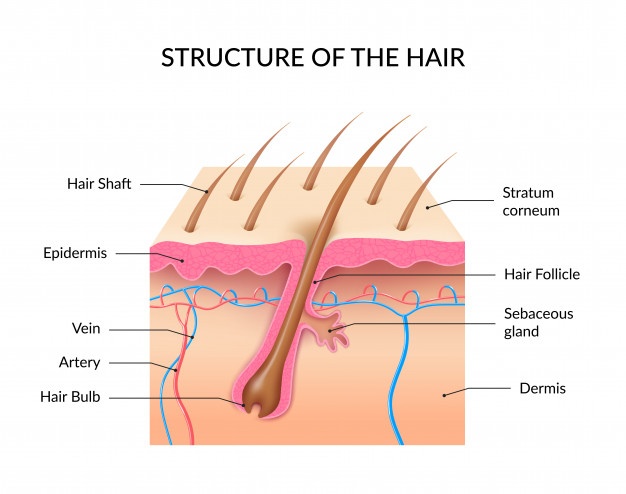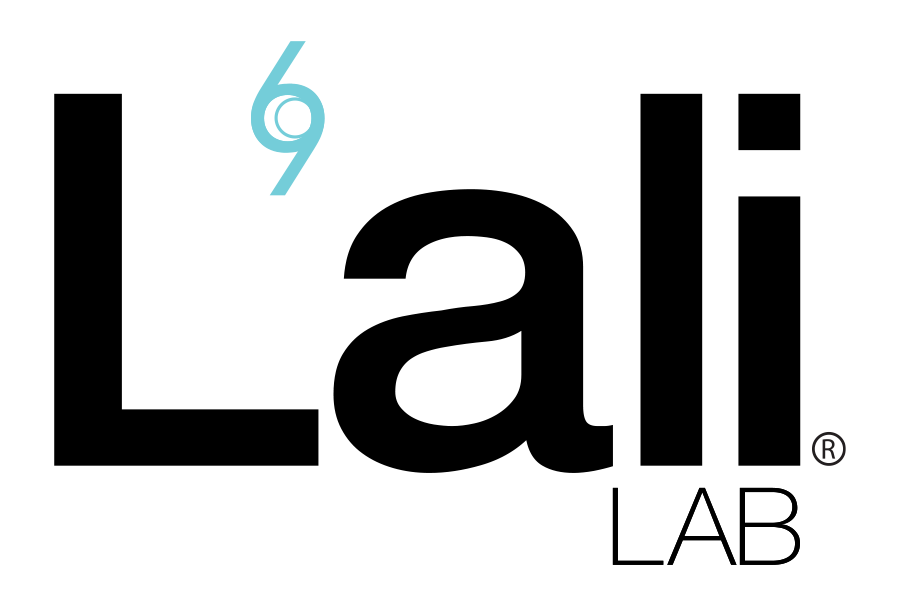Informed consent, IQ: I-question
Hair structure
What
What is the structure of the hair?
Anatomically, the hair is divided into stem/shaft and root.
The root of the hair is located in the dermis, in a hair sac called a follicle. The stem can be positioned at a different angle to the skin – from 10 to 90 degrees. The too small angle of growth (10-20 degrees) does not allow you to make the hairstyle you want. The reason is that in this situation it would be very difficult for us to place the hair on the opposite side. In addition, if the angle of growth is too small, so-called ingrown hairs can form and cause inflammation.
The stem/shaft is the visible part of the hair that is on the surface of the skin. In a cross section of the stem, we can observe its structure. In the center is a brain substance (medulla), which is absent in the vellus hairs (covering the arms, legs and body). The middle layer is called the cortex, and the outer shell is made up of the cuticle. The brain substance (the pith) is composed of cells that are not fully keratinized. The cortex makes up 90% of the hair and is composed of a cell complex rich in keratin. The strength of the hair depends on it.

The cuticle is made up of 6 to 9 layers of cells. Its structure resembles a tiled roof or the surface of a pine cone. Under the influence of an alkaline environment (ordinary soap), the scales of the cuticle open, and under the influence of an acidic environment, they close. As a rule, when hair is damaged by an external factor, the cuticle is the first to suffer. On the other hand, hair is one of the most resistant structures to external influences. It ranks second after that of the teeth.
The hair follicle is a cavity in which the so-called bulb is located, and in it – the very root of the hair. The bulb is like a “matrix” of constantly dividing cells. It is also known that it has its own immunity. Damage to it is one of the causes of the appearance of alopecia areata (hair loss). In the lower part of the bulb is the so-called dermal papilla. It contains blood vessels and is an extremely important part of the structure of the follicle. Like a computer, it controls the condition and growth of the hair. If the papilla dies, so does the entire hair. At the same time, if for some reason the hair dies (for example, it is pulled out by the root), but the papilla is preserved, a new hair grows in its place. The structure of the hair follicle consists of two types of glands – sebaceous (usually 2-3) and sweat. The hair follicle also has a muscle that serves to lift the hair.
The total amount of sebaceous glands in the human body reaches 200,000, and in one day the amount of fatty substances that is released is about 50 g. The activity of the sebaceous glands depends on: gender, age, the moment of the menstrual cycle, the state of the nervous and endocrine system and also from the way of eating. The main function of the sebaceous glands is to produce sebum with which to “lubricate” the hair and the epidermis. Thus, a hydro-lipid layer (water-lipid mantle) is formed, which performs a protective function. You can find detailed information about skin and hair pH here.
How
How does hair grow?
- growth stage (anagen phase);
- transitional stage (catagen phase);
- resting phase (telogen phase).
The follicle is rich in blood vessels. Men are known to be prone to baldness. This is because the blood vessels of the hair follicle suffer from increased sensitivity to male sex hormones (androgens), in particular to dihydrotestosterone, and also to 5-alpha-reductase, an enzyme that converts testosterone into dehydrotestosterone.
In the period of sexual development, the amount of androgens in the blood increases, the blood vessels get spasms, which disrupt the supply of the hair follicle, as a result of which baldness occurs. It is important to note that only hair from certain areas of the head (hormonally sensitive areas), not all hair on the human body, is hypersensitive to androgens.
The length (uncut) of hair primarily depends on race. The length of hair in the European race occupies an intermediate place in this ranking. In addition, it should not be forgotten that the same hair does not grow throughout life: the stage of development of one hair lasts 3-6 years, after which a new one begins to grow in its place. It is considered that one hair grows by 1 cm per month. It is normal if 40 to 80 hairs fall out in one day. The thickness (density) and color of hair depend on a person’s age and belonging to one or another race. Usually, people of the Mongoloid race have the densest and stiffest hair structure. In newborns, the hair is 2-3 times thinner than in adults. As we age, hair thins. Therefore, in babies it is 20-40 microns, in an adult it is 70-100 microns, and in old people 50-70 microns. Hair density is greatest in redheads (up to 100 microns), thinner in brunettes (75 microns), even thinner in people with brown hair, and thinnest in blondes (50 microns).
What
What types of hair are there according to hair shape?
1.Straight hair – It often looks thin and without volume, but this is not due to the thickness of the hair, but to its shape. Most people with straight hair suffer from rapid oiliness, as the sebum spreads more easily along the length of the hair.
2. Wavy hair – When applying aggressive procedures (temperature, dyeing) that damage the structure of the hair, it can often appear absolutely straight.
2а. Wavy type A – So called “beach hair”. This type is characterized by a slight bending of the hair shaft, which makes the hair look carelessly disheveled. Not strongly affected by static electricity. In order to keep the beautiful look, it is good to use light styling products.
2b. Wavy type B – This type is characterized by a slight bending of the hair shaft and is usually easily fixed with styling products.
2c. Wavy type С – Static electricity is the number 1 enemy of wavy type C hair. Although the natural shape of the hair often makes it look styled, extra fixing is needed to keep the shape all day. The hair profile has a characteristic S-shaped appearance.
3. Curly hair – It is traditionally covered by a thinner outer layer (cuticle), which makes it thinner overall and helps the hair to dry faster. Hydration is curly hair’s first friend!
3a. Curly type A – This type of hair is characterized by large loose spiral curls and if the hair is short, the shape starts at the root. It is easy to style, but avoid combing it often or tying it in a ponytail for a long time.
4. Kinky hair (Zig-Zag shape) – Kinky hair is traditionally covered with a thinner outer layer (cuticle), which makes it thinner overall and helps the hair dry faster, which goes double here. Combing is almost impossible. While with straight and wavy hair, the direct use of natural oils can lead to thinning, in this case they help to “tame” the frizz and retain moisture in the hair. Hydration is kinky hair’s first friend!
4a. Kinky type А – This hair type is characterized by dense, fine S-shaped curls with wonderful volume. Combing is almost impossible and would result in highly charged hair sticking out in all directions. It can be fluffy soft or hard like wire.
4b. Kinky type В – This hair type is characterized by its great zig-zag shape and incredible volume. The curls are sharp and irregularly shaped.
4c. Kinky type С – This hair type is characterized by its very fine zig-zag shape and exceptional volume. The curls are very tight and their structure extremely delicate.

How
How is hair color formed?
- eumelanin (responsible for black-brown shades);
- pheomelanin (for yellow – red shades).
Blond hair – Only about 5% of the European and North American population has naturally blonde hair. This is largely due to the fact that blonde hair usually darkens with age. The red color is determined by the low amount of the dark pigment eumelanin. From an evolutionary perspective, the blonde color is associated with the total amount of melanin produced by the body and the need for increased vitamin D production in fair-skinned people.
Brown hair – This is the second most common hair color, with over 10 different shades. It can vary from dark brown (almost black) to a very light shade (almost blond), depending on the ratio of the two pigments eumelanin and pheomelanin. It is especially common in Central, Southern and Eastern Europe, North America and South Africa.
Black hair – This is the most common hair color in the world. It is seen among all races and ethnicities, with the fewest people with black hair being found in Northern Europe. Shades can vary widely.
Red hair – Only 1-2% of the Earth’s population has red hair, and it is most often found in Northern and North-Western Europe. The color is due to a recessive allele (non-expressing form of the gene) that probably arose 20,000 to 100,000 years ago. Hereditary “red” hair can skip several generations before reappearing. Studies show that people with red hair are paler, have more freckles and are more prone to sunburn.
What
What is the difference between hair and scalp products?
Hair loses moisture much faster than the skin, because once it “comes out” from its root it is no longer technically “alive”, and sebum, which serves as a natural moisturizer and emollient, usually cannot reach its entire length. Moisturizers in hair products are different from skin/scalp products as they need to both protect the hair and not make it look flat and greasy.
Another significant difference is the pH of the products. In order for the hair to look smooth and healthy, the pH should be in the low part of the acid scale (3.5-4), and at the same values the sensitivity of the scalp increases and itching, redness and flaking often occur. This is also the reason why hair conditioners should not be applied to the root of the hair. Masks, on the other hand, have a higher pH of 5-6, with the aim being that the active ingredients affect the skin of the scalp to nourish the hair root and at the same time penetrate through the “open” hair, nourishing it as well.
Who
Erdoğan Anatomy and Physiology of Hair. 2017
Yang F-C, Zhang Y, Rheinstädter The structure of people’s hair. PeerJ. 2014
Schlake Determination of hair structure and shape. Seminars in Cell & Developmental Biology 18. 2007.
Българска Асоциация Трихология, Анатомия на Косъма, 2017
Hoffman M, MD. Human Anatomy: Picture of the Hair. webmd.com
Photo: Deena



